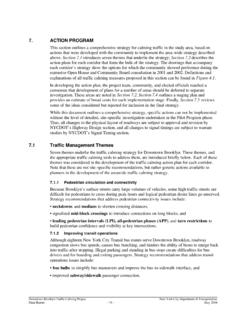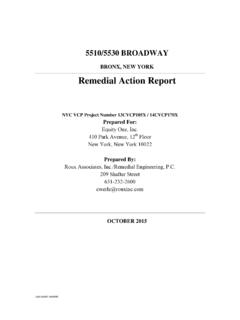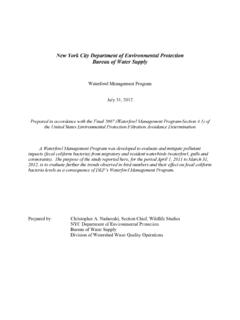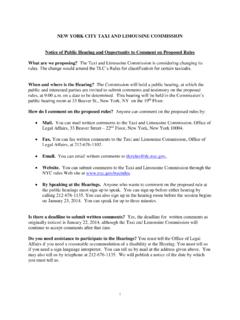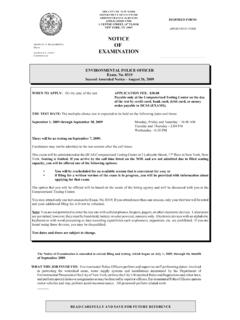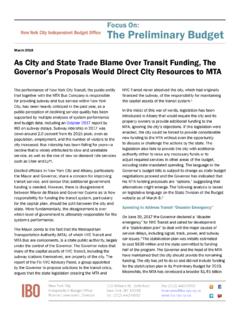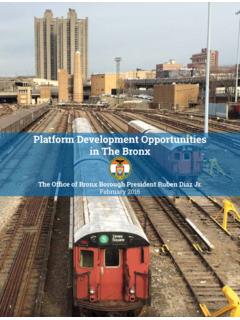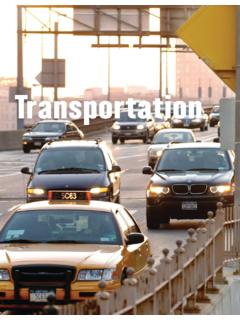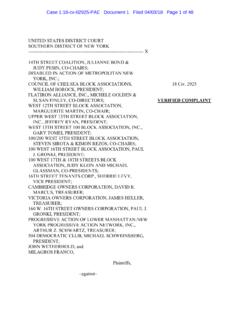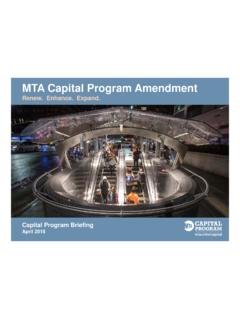Transcription of Chapter 22: Alternatives A. INTRODUCTION - home.nyc.gov
1 22-1 Chapter 22: Alternatives A. INTRODUCTION Consistent with city Environmental Quality Review (CEQR) requirements, this Chapter of this Supplemental Environmental Impact Statement (SEIS) examines Alternatives to the proposed project, which is a modification to the previously approved Willets Point Development plan . CEQR requires the examination of a No action Alternative, in which a proposed project would not be undertaken. CEQR also recommends the examination of Alternatives that would have no unmitigated significant adverse impacts, if unmitigated significant adverse impacts are predicted for a proposed project. Therefore, the Alternatives examined in this Chapter are the No action Alternative and the No Unmitigated Significant Impacts Alternative.
2 As described in detail below in Section B, Summary of Findings 2008 FGEIS and Subsequent Technical Memoranda, the other Alternatives evaluated in the 2008 FGEIS are not being considered in this analysis. This analysis first examines the No action Alternative, which describes the conditions that would exist if the proposed project were not implemented. The second alternative examined below is the No Unmitigated Significant Impacts Alternative, which examines the level of development that would be necessary to avoid all the potential unmitigated impacts associated with the proposed project. PRINCIPAL CONCLUSIONS NO action ALTERNATIVE The No action Alternative assumes the continuation of existing uses on the various portions of the project site.
3 Since this alternative would allow the continued industrial use of the District, it would not allow for development of affordable housing, community facilities, schools, and public open space. It also would not comprehensively remediate contaminated soils and groundwater, nor provide new sanitary and storm sewers; as a result, there would continue to be degraded water quality and potential impacts to aquatic biota through the continued discharge of wastewater, polluted storm water, and sediments from the District to the Flushing River, Flushing Bay, and groundwater aquifers. Because the No action Alternative would not develop new retail and entertainment uses at Willets West and the District, it would not generate the substantial economic and civic benefits resulting from the proposed project in the way of new jobs and tax revenues.
4 Moreover, this alternative would not advance a number of the Downtown Flushing Development Framework s fundamental goals, including the creation of a regional destination that would enhance economic growth in Downtown Flushing and Corona, improvement of environmental conditions, and integration of new development in the District with surrounding amenities. The former Empire Millwork Corporation Building would remain under private ownership in the No action Alternative and could be demolished as-of-right; mitigation measures such as photographic documentation would not be required. Willets Point Development 22-2 NO UNMITIGATED SIGNIFICANT IMPACTS ALTERNATIVE The No Unmitigated Significant Impacts Alternative explores modifications to the proposed project that would avoid the unmitigated significant impacts to historic and cultural resources, traffic, transit, and pedestrians: For historic and cultural resources, this alternative would avoid the demolition of the former Empire Millwork Corporation Building that would occur with Phase 2 of the proposed project.
5 Although this could be achieved through adaptive reuse, exterior elements would still need to be upgraded to comply with building codes and noise attenuation requirements, and flood protection measures such as gates or pumps would be required to comply with flood insurance requirements. Overall, this alternative would reduce the footprint of any new development, which would result in greater density in the remainder of the District, fewer housing units, less open space, or some combination of these possibilities. As noted above, the former Empire Millwork Corporation Building could be demolished as-of-right under existing conditions, and mitigation measures such as photographic documentation would not be required.
6 For traffic, the proposed project and the potential future development on Lot B would result in significant adverse impacts that cannot be fully alleviated with practical mitigation measures. Because of existing congestion at a number of intersections, even a minimal increase in traffic would result in unmitigated impacts. Based on a sensitivity analysis of intersections within the study area, it was determined that in all three phases of the proposed project, the addition of five or fewer vehicles through some intersections would trigger an impact that cannot be fully mitigated. Thus, almost any new development at the project site would result in unmitigated traffic impacts, and no reasonable alternative could be developed to avoid such impacts.
7 For transit, the proposed project and potential future development on Lot B would result in significant adverse subway line-haul impacts on the Manhattan-bound subway line express service during the 2028 and 2032 AM peak periods and on station operations at the Mets-Willets Point subway station under the 2018, 2028, and 2032 With action conditions. Should New york city Transit (NYCT) revert back to its pre-CitiField station operating plan for the Mets-Willets Point subway station, the significant adverse impacts on station operations may potentially be deemed unmitigatable. Although the city had consulted with the New york Metropolitan Transportation Authority (MTA) on extending regular Long Island Rail Road (LIRR) service to Willets Point, which would be expected to provide substantial relief to the No.
8 7 subway line and may prevent this significant adverse subway impact from materializing, the implementation of the LIRR service improvement would depend on whether the actual future demand shows that such service improvement is warranted. It should be noted that this significant adverse line-haul impact on the No. 7 line would not occur until Phase 2 should NYCT be able to process an additional Manhattan-bound express train during the AM peak hour, as assumed in the Draft SEIS (DSEIS). To avoid this potentially unmitigatable impact, portions or all of Phase 1B and Phase 2 of the proposed project and the potential future development on Lot B would need to be eliminated from the current development plan .
9 Almost any new development at the project site would result in the potentially unmitigatable impact on station operations at the Mets-Willets Point subway station, and no reasonable alternative could be developed to avoid such impacts without substantially compromising the proposed project s stated goals. Chapter 22: Alternatives 22-3 For pedestrians, the proposed project and potential future development on Lot B would result in significant adverse impacts at five seven study area crosswalks upon Phase 1A completion, five study area crosswalks upon and Phase 1B completion, and seven study area crosswalks upon the Phase 2 full build-out in 2032, 2018 and 2028, respectively, and at eight study area crosswalks upon the Phase 2 full build-out in 2032.
10 No reasonable alternative could be developed to avoid these impacts without substantially compromising the proposed project s stated goals. B. SUMMARY OF FINDINGS 2008 FGEIS AND SUBSEQUENT TECHNICAL MEMORANDA The 2008 Final Generic Environmental Impact Statement (FGEIS) examined five Alternatives , including: A No action Alternative, which described the conditions that would exist if the 2008 Willets Point Development plan were not implemented; A No Unmitigated Impact Alternative, which examined the level of development that would be necessary to avoid all the potential unmitigated impacts associated with the 2008 Willets Point Development plan ; A Flushing Bridge Alternative, which assessed the 2008 Willets Point Development plan with a new pedestrian bridge connecting the District and Downtown Flushing; A Municipal Services Alternative, which evaluated conditions that would have been likely to occur if the District were not rezoned but additional municipal services were provided to the District; and A Staged Acquisition Alternative, in which properties in the District would have been acquired and infrastructure developed over time.
